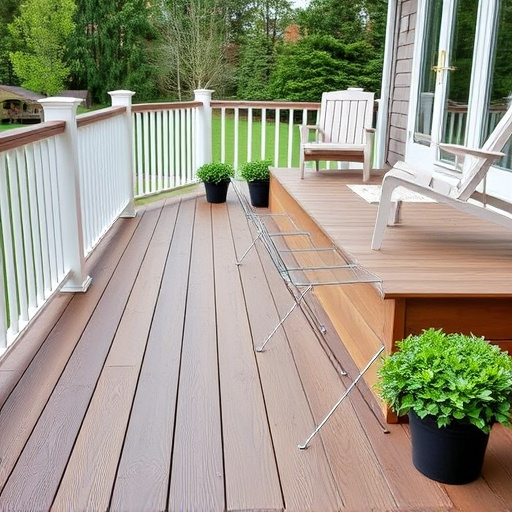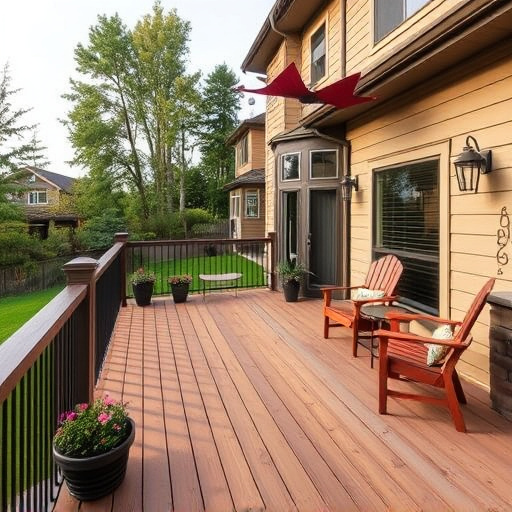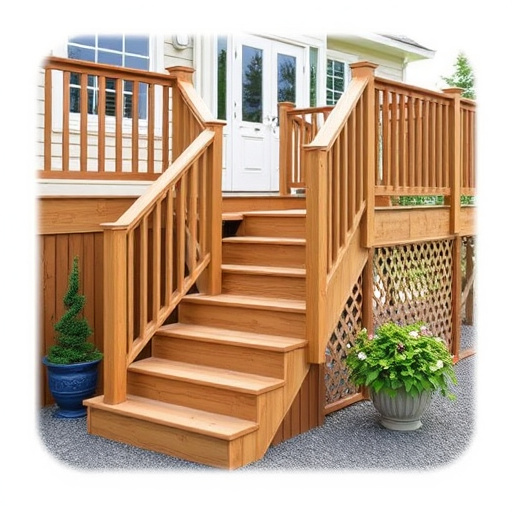Protect Your Raised Deck: Weather-Resistant Strategies for Longevity
Weather-related damage poses significant risks to raised decks, necessitating regular maintenance to…….
Welcome to an in-depth exploration of the fascinating concept of a raised deck, a design element that has captured the attention of architects, urban planners, and developers worldwide. This article aims to unravel the intricacies of raised decks, offering readers a comprehensive understanding of their purpose, applications, and global impact. By delving into various aspects, from historical roots to future prospects, we will uncover why this simple yet powerful design choice is leaving its mark on modern architecture and urban development.
Definition: A raised deck, also known as a elevated platform or terrace, refers to a structural element that is built above the ground level, creating a distinct, elevated space. It involves constructing a robust framework that supports a solid surface, offering a unique alternative to traditional flat flooring.
Core Components:
Structural Framework: This forms the backbone of the raised deck and can be constructed from various materials such as wood, metal, or concrete. The frame must be designed to bear the weight of the deck, any furniture, and the intended use.
Decking Material: The surface that completes the elevated platform. Options range from natural wood, composite materials, to stone or tile. The choice depends on aesthetics, durability, and maintenance preferences.
Support System: Includes components like joists, beams, and pillars that connect the framework to the ground or existing structures, ensuring stability and structural integrity.
Historical Context: The concept of raised decks has deep historical roots, dating back to ancient civilizations. From Roman villas with elevated terraces to traditional Japanese tea houses, these elevated spaces have long been valued for their aesthetic appeal and functional benefits. Modern interpretations build upon these traditional foundations, incorporating innovative materials and design techniques to create versatile outdoor living areas.
The popularity of raised decks has transcended geographical boundaries, influencing various cultural contexts and architectural styles worldwide. Here’s a glimpse into its global impact:
| Region | Impact and Trends |
|---|---|
| North America | Raised decks are prevalent in suburban homes, offering outdoor entertainment spaces. Modern designs incorporate glass railings for a seamless indoor-outdoor flow. |
| Europe | In urban settings, raised decks transform rooftops into green oases, promoting sustainable living. The use of natural materials like wood adds warmth to modern cityscapes. |
| Asia Pacific | Balconies and terraces in high-rise apartments often feature raised deck designs, providing residents with private outdoor retreats. |
| Middle East | Elevated platforms are used in traditional architecture, blending contemporary design with cultural heritage. |
Key Global Trends:
Sustainable Living: Many regions are adopting raised decks as a way to incorporate green spaces into urban environments, promoting sustainability and biodiversity.
Outdoor Entertainment: In suburban areas, raised decks have become popular for hosting gatherings and entertaining guests, blurring the lines between indoor and outdoor living.
Cultural Fusion: The integration of traditional elements with modern design, as seen in various global contexts, showcases the versatility of raised decks in adapting to diverse cultural preferences.
The economic landscape surrounding raised decks is multifaceted, involving various sectors and market dynamics.
Market Dynamics:
Investment Patterns:
Economic System Implications:
Technological innovations have played a pivotal role in shaping modern raised deck designs and functionality:
Modular Systems: Pre-fabricated modular deck systems offer faster installation times and cost savings, allowing for quicker project turnaround. These systems can be easily customized to various designs.
Smart Decking: Integration of smart technology enables controlled lighting, music systems, and automated shade structures, transforming raised decks into high-tech outdoor living spaces.
Durable Materials: Advances in composite decking materials provide enhanced durability, resistance to rot, and lower maintenance requirements compared to traditional wood options.
Digital Design Tools: 3D modeling software and virtual reality (VR) technologies enable architects and designers to create immersive digital prototypes, aiding in client visualization and project planning.
The development of raised decks is subject to various policies and regulations that ensure safety, structural integrity, and compliance with building codes:
Building Codes: Local building departments enforce regulations related to deck construction, including minimum spacing, load-bearing capacity, and railing requirements.
Zoning Laws: Zoning ordinances may dictate the allowed uses of raised decks, especially in residential areas, to maintain neighborhood harmony and safety standards.
Structural Safety Standards: Organizations like the International Code Council (ICC) set guidelines for deck construction, ensuring structural integrity and mitigating potential risks.
Environmental Regulations: In some regions, especially with limited outdoor space, there may be policies encouraging the use of raised decks to preserve green spaces and reduce urban sprawl.
Despite its numerous benefits, the concept of raised decks is not without challenges and criticisms:
Challenges:
Installation Complexity: Building a raised deck requires skilled labor and precise planning, potentially leading to higher installation costs in some regions.
Weather Exposure: Unprotected decks may be susceptible to damage from extreme weather events, requiring regular maintenance and repairs.
Accessibility: For individuals with mobility issues, navigating raised decks can be challenging, emphasizing the need for inclusive design considerations.
Criticisms:
Some critics argue that raised decks contribute to urban heat islands due to dark decking materials absorbing sunlight, though this effect can be mitigated with reflective surfaces and proper ventilation.
There is a perceived lack of versatility in certain designs, as some raised decks may be limited to specific architectural styles or settings.
In the bustling cityscape of New York, a luxury high-rise apartment building transformed its flat rooftops into lush green oases with raised deck systems. The project aimed to provide residents with a serene escape from urban life. The design incorporated eco-friendly materials, vertical gardens, and comfortable seating areas, creating a harmonious blend of nature and modern architecture.
Key Takeaways:
A coastal community in San Diego embraced raised decks as a central design element, seamlessly integrating outdoor living with breathtaking ocean views. The development featured private terraces at each residence, offering residents a place to relax and enjoy the coastal climate.
Lessons Learned:
In Kyoto, a historic temple underwent a restoration project that included the recreation of traditional elevated platforms or tsubo. These raised decks, once common in Japanese architecture, provide visitors with a unique perspective of the ancient structures and their serene ambiance.
Significance:
The future of raised decks looks promising, with several emerging trends shaping its evolution:
Sustainable Innovation: Expect a surge in eco-friendly deck materials, including biodegradable options and recycled composites, as the industry aligns with global sustainability goals.
Smart Home Integration: As smart home technology advances, raised decks may become increasingly connected, offering automated lighting, temperature control, and entertainment systems integrated into the deck surface.
Modular Design Flexibility: Modular deck systems will continue to gain popularity for their speed of installation and customizable design options, catering to a wide range of architectural styles and preferences.
Incorporation of Green Spaces: The trend towards urban greening will likely lead to more raised decks with vertical gardens, green walls, and native plant species, promoting biodiversity and enhancing urban ecosystems.
The concept of a raised deck has evolved from a simple architectural element to a transformative design tool that enriches outdoor living spaces worldwide. Its versatility, functionality, and aesthetic appeal have captivated architects, developers, and homeowners alike. As technology advances and global trends shift towards sustainable and connected living, the role of raised decks in shaping urban and suburban landscapes will only grow more prominent.
By embracing innovative materials, smart technologies, and inclusive design principles, the future of raised decks promises to offer enhanced outdoor experiences while addressing environmental and accessibility concerns. This comprehensive exploration highlights the significance of raised decks as a dynamic element in modern architecture and urban development, leaving readers equipped with valuable insights into its global impact and potential.
Q: How do I choose the right materials for my raised deck?
A: Consider factors like climate, maintenance preferences, budget, and aesthetic goals. Natural wood offers a classic look but requires more maintenance, while composite materials are low-maintenance and durable. Concrete is versatile and strong but may need additional finishing touches.
Q: Can raised decks be installed in my backyard without permits?
A: Building codes and zoning laws vary by location. It’s essential to check with your local authorities to ensure compliance and avoid potential fines or legal issues. Some regions require permits for deck installations, especially when they involve structural alterations or certain size thresholds.
Q: How do I make my raised deck more accessible for those with mobility challenges?
A: Consider designing the deck with a gentle slope for easier navigation. Ensure there is enough clearance for wheelchairs and consider adding handrails or grab bars for support. Selecting materials with anti-slip properties can also enhance accessibility.
Q: Are raised decks susceptible to damage from extreme weather?
A: Properly designed and maintained raised decks can withstand various weather conditions. Using weather-resistant materials, providing adequate overhangs, and ensuring proper drainage can help protect the deck from rain, snow, and extreme temperatures. Regular inspection and maintenance are crucial for long-term durability.

Weather-related damage poses significant risks to raised decks, necessitating regular maintenance to…….

Maintaining a raised deck requires dedicated care, focusing on proper drainage and regular cleaning…….

Maintaining a raised deck involves choosing the right sealant based on material type (wood, composit…….